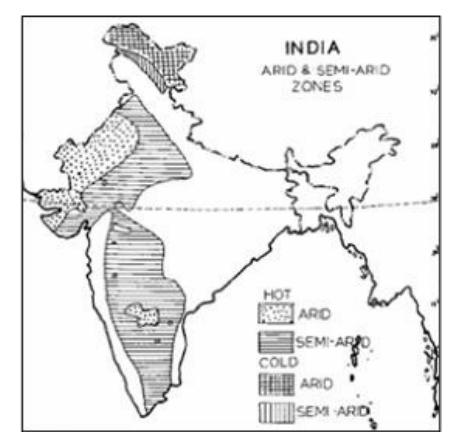
Dry-land farming holds paramount significance in the arid and drought-prone regions of India, where water scarcity poses a constant challenge to traditional agriculture. As a method tailored to suit regions with erratic and limited rainfall, dry-land farming plays a crucial role in ensuring food security and livelihood sustainability for millions of people. In the face of climate change and increasing instances of water stress, the adoption and promotion of dry-land farming practices become indispensable. This form of agriculture not only conserves water resources but also enhances soil fertility and resilience, offering a viable solution to the agrarian woes of drought-prone areas. Examining the importance of dry-land farming in the context of India sheds light on its role as a resilient and adaptive strategy, steering agricultural practices towards sustainability amid climatic uncertainties.
Contents
Answer
Out of the 141 million hectares of estimated net sown area, close to 80 million hectares is under dryland farming, generally practiced in arid regions of the country with annual rainfall less than 750 mm and the crop-growing season is less than 200 days.

Dry-land farming is important in the drought-prone regions of India for several reasons
- Reduce the risk of crop failure
- Cultivation is in accordance with agro-ecological regions of the country
- Most of dryland crops are hardy and drought resistant E.g., Jowar, bajra, ragi, pulses, oilseeds.
- Water-efficient way of farming
- Hardy crops do not require much irrigation-major drain on water resources, Eg.90% of the total ground water extracted is used in agriculture mainly for irrigation
- It relies mainly on rainfall
- Help in correcting the cropping pattern (CP)
- CP currently is skewed in favour of wheat and water intensive paddy
- Not following the agroecological zonation of the country E.g., cultivation of sugarcane in semiarid regions of Rajasthan
- Help in improving farmer’s income
- Dryland agriculture support livestock-additional income
- Reduced input cost as dryland farming is majorly is not input intensive
- Potential of providing cattle feed and fodder, potential to assist in the white revolution
- Combat the problems of malnutrition
- Hardy and nutritious crops including Jowar, bajra, ragi, pulses, oilseeds, cottonseed, sunflower, and safflower are excellent source of nutrition E.g., Pulses are cheapest source of protein
- Corse grains and millets are known as nutri cereals


- Helps lessen the severity of the oil crisis
- Dryland farming involves cash crops.eg. growing Jatropha, the liquid it produces can be added to petroleum goods without affecting their efficiency
- For growth of the agro-processing businesses
- The industrial crops like cotton, groundnuts, oilseeds, pulses are major inputs to agro processing businesses
- Help in making agriculture more export-oriented.
- For balanced development and climate resilient sustainable agriculture
- Cultivation is as per agroeconomic regions, thus less strain on critical inputs like water resources
- Less synthetic input intensive, reduced cost of production and improved income levels However, there are challenges in dry-land farming:
- Dry-land farming is practiced in areas with low rainfall, making it difficult to grow crops without irrigation.
- Rainfall in drought-prone regions is often unpredictable with high variability, make it difficult to plan for the growing season and can lead to crop failure.
- Soils in drought-prone regions are often poor in quality, difficult to grow crops without proper soil management practices.
Despite the challenges, dry-land farming is an important way of farming in the drought-prone regions of India. Rainfed Area Development Programme, National Mission on Sustainable Agriculture, and Micro Irrigation Fund (MIF) are steps in the right direction.
In case you still have your doubts, contact us on 9811333901.
For UPSC Prelims Resources, Click here
For Daily Updates and Study Material:
Join our Telegram Channel – Edukemy for IAS
- 1. Learn through Videos – here
- 2. Be Exam Ready by Practicing Daily MCQs – here
- 3. Daily Newsletter – Get all your Current Affairs Covered – here
- 4. Mains Answer Writing Practice – here

